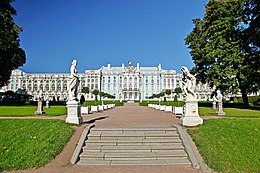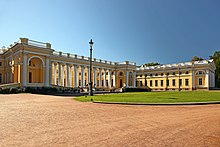
Tsarskoye Selo (Russian: Ца́рское Село́, IPA: [ˈtsarskəje sʲɪˈlo] , lit. 'Tsar's Village') was the town containing a former residence of the Russian imperial family and visiting nobility, located 24 kilometers (15 mi) south from the center of Saint Petersburg. The residence now forms part of the town of Pushkin. Tsarskoye Selo forms one of the World Heritage Site Saint Petersburg and Related Groups of Monuments.
The town bore the name Tsarskoye Selo until 1918. The new Bolshevik government of Soviet Russia renamed it as Detskoye Selo (Russian: Детское Село, lit. 'Children's Village'), which it held from 1918–1937. At that time, it was renamed under Stalin's government as Pushkin (Russian: Пушкин) after the famous Russian poet and writer. It is still known by that name.
History

The area of Tsarskoye Selo, once part of Swedish Ingria, first became a Russian royal/imperial residence in the early 18th century as an estate of the Empress-consort Catherine (later Empress-regnant as Catherine I, r. 1725–1727), for whom the Catherine Palace is named.
When Peter the Great took possession of the mouth of the Neva, a Finnish village, Saari-mois, stood on the site now occupied by the town, and its Russified name Sarskaya was changed into Tsarskoye when Peter presented it to his wife Catherine. It was especially embellished by the tsaritsa Elizabeth. Under Catherine II., a town, Sophia, was built close by, but its inhabitants were transferred to Tsarskoye Selo under Alexander I. The railway connecting the town with St Petersburg was the first (1838) to be constructed in Russia.
The Alexander Palace (built from 1792 onwards) was first the home of Catherine the Great's grandson, the Grand Duke Alexander Pavlovich, who later became Emperor Alexander I (r. 1801–1825). After his abdication, Nicholas II and his family were held there by revolutionary forces under house arrest until 13 August 1917. People built homes in the town where they also came to live when the court was in the country.
The Royal Forestry School, perhaps the first such school in Russia, was founded in Tsarskoye Selo in 1803. It was moved to Saint Petersburg in 1811 and developed as the Imperial Forestry Institute.
According to historian Robert K. Massie,
"Tsarskoe Selo was a magnificent symbol, a supreme gesture, of the Russian autocracy. At the edge of the great St. Petersburg plain, fifteen miles south of the capital, a succession of Russian tsars and empresses had created an isolated, miniature world, as artificial and fantastic as a precisely ordered mechanical toy. Inside the park, monuments, obelisks and triumphal arches studded eight hundred acres of velvet green lawn. An artificial lake, big enough for small sailboats, could be emptied and filled like a bathtub. At one end of the lake stood a pink Turkish bath; not far off, a dazzling red-and-gold Chinese pagoda crowned an artificial hillock." The two palaces stood five hundred yards apart in the Imperial Park. "Outside the palace gates, Tsarskoe Selo, was an elegant provincial town..." The town included "The mansions of the aristocracy, lining the wide tree-shaded boulevard which led from the railway station to the gates of the Imperial Park..."
Nickname for elite Soviet neighborhoods
In the decades of the Soviet Union, people applied the nickname "the Tsar's village" to the blocks and small neighborhoods in major cities that housed the nomenklatura (Soviet elites). Their stores were better stocked, although they were still affected by Soviet-era shortages. The buildings in the neighborhoods were better designed, constructed and maintained. For instance, one such neighborhood, west of Moscow, contained less industry and more parks than any other neighborhood.
Monuments

- Alexander Palace and associated park
- Catherine Palace and associated park
- Sophia Cathedral
- Tsarskoye Selo Lyceum
- Feodorovsky Gorodok
Gallery
-
 Grotto pavilion in Catherine Park of Tsarskoye Selo, Saint Petersburg, Russia
Grotto pavilion in Catherine Park of Tsarskoye Selo, Saint Petersburg, Russia
-
 Catherine Palace with a view of the Cameron Gallery; Tsarskoye Selo in a watercolor by Luigi Premazzi, c. 1855
Catherine Palace with a view of the Cameron Gallery; Tsarskoye Selo in a watercolor by Luigi Premazzi, c. 1855
-
 The Catherine Palace, the Great Hall
The Catherine Palace, the Great Hall
-
 Fire in the Catherine Palace, 1942
Fire in the Catherine Palace, 1942
-
 Cameron Gallery, Catherine Palace
Cameron Gallery, Catherine Palace
-
 Jubilee exhibition for the 200th anniversary of Tsarskoye Selo, 1911
Jubilee exhibition for the 200th anniversary of Tsarskoye Selo, 1911
-
 Catherine Palace at the main entrance, September 9, 1911. Adolphe Kégresse seated behind the wheel of the Imperial "Benz".
Catherine Palace at the main entrance, September 9, 1911. Adolphe Kégresse seated behind the wheel of the Imperial "Benz".
-
 Catherine Park, pavilion "grotto", 1910
Catherine Park, pavilion "grotto", 1910
-
 Catherine Park, Pyramid, 1910
Catherine Park, Pyramid, 1910
-
 Catherine Park, Palladian Bridge
Catherine Park, Palladian Bridge
-
 Alexander Palace, 1918
Alexander Palace, 1918
-
 Kegresse track outside Alexander Palace, January 1917
Kegresse track outside Alexander Palace, January 1917
-
 "Chapel" in Alexander Park, 1897
"Chapel" in Alexander Park, 1897
-
 Large Chinese Bridge in Alexander Park, 1910
Large Chinese Bridge in Alexander Park, 1910
-
 "Grand Caprice" in Alexander Park, 1911
"Grand Caprice" in Alexander Park, 1911
-
 Farm outbuilding with a tower in Alexander Park, 1910
Farm outbuilding with a tower in Alexander Park, 1910
-
 Tsarskoye Selo Imperial Station/Emperor railway station in Pushkin town, 1910s
Tsarskoye Selo Imperial Station/Emperor railway station in Pushkin town, 1910s
See also
- Treaty of Tsarskoye Selo
- Emperor railway station in Pushkin town
- Feodorovsky Gorodok
- Adolphe Kegresse
References
- Jabado, Salwa; Fodor's (2008). Fodor's Moscow and St. Petersburg. New York: Random House. p. 292. ISBN 978-1-4000-0717-2.
-
 One or more of the preceding sentences incorporates text from a publication now in the public domain: Chisholm, Hugh, ed. (1911). "Tsarskoye Selo". Encyclopædia Britannica. Vol. 27 (11th ed.). Cambridge University Press. p. 348.
One or more of the preceding sentences incorporates text from a publication now in the public domain: Chisholm, Hugh, ed. (1911). "Tsarskoye Selo". Encyclopædia Britannica. Vol. 27 (11th ed.). Cambridge University Press. p. 348.
- ^ Massie, Robert (1967). Nicholas and Alexandria. New York: Ballantine Books. pp. 117–130. ISBN 9780345438317.
- St. Petersburg Encyclopedia. Accessed: May 6, 2012.
-
Compare:
Gessen, Masha (2017). The Future is History: How Totalitarianism Reclaimed Russia. Granta Books. ISBN 9781783784011. Retrieved October 22, 2020.
Under the Soviets the name 'the Tsars' Village' began attaching itself to blocks and small neighborhoods that housed the Soviet elites.
The stores here were better stocked, even though they were affected by the shortages. The buildings were better designed and constructed. - Masha Gessen, (2017). The Future Is History: How Totalitarianism Reclaimed Russia.
Further reading
- King, Greg (2006). The Court of the Last Tsar (hardback). Hoboken: John Wiley & Sons. ISBN 978-0-471-72763-7.
External links
- Tsarskoye Selo, Pushkin town, historical facts of the city, map, local weather, directions from St. Petersburg
- The State Museum of Tsarskoye Selo Archived November 16, 2018, at the Wayback Machine
- Alexander Palace Time Machine The Alexander Palace Time Machine
- Tsarskoye Selo in 1910 – a guide to the Palaces, Park and Town
- Photo Tours of Tsarskoye Selo
- Last Days at Tsarskoe Selo Last Days at Tsarskoye Selo by Count Paul Beckendorff
- Photographic views of Tsarskoye Selo, c. 2002 Archived March 3, 2016, at the Wayback Machine The Nostalgic Glass
- Tsarskoye Selo Photos Iconicarchive Gallery
- Bernard DeCou's colored photos of Tsarskoye Selo, c. 1931
| Showplaces in Tsarskoye Selo museum complex | ||
|---|---|---|
| (architect), year of open | ||
| Palaces |
| |
| Parks |
| |
| landscape architecture |
| |
| Russian imperial palaces and residences | |
|---|---|
| Imperial residences | |
| Grand ducal residences | |
| Outside the Russian Federation | |
| In Crimea | |
| Historical | |
59°43′24″N 30°24′57″E / 59.72333°N 30.41583°E / 59.72333; 30.41583
Categories: